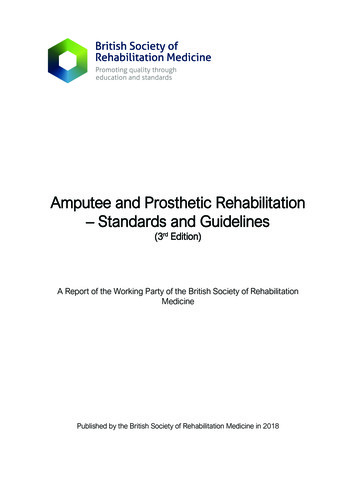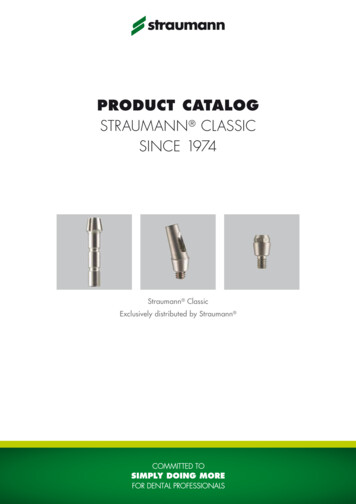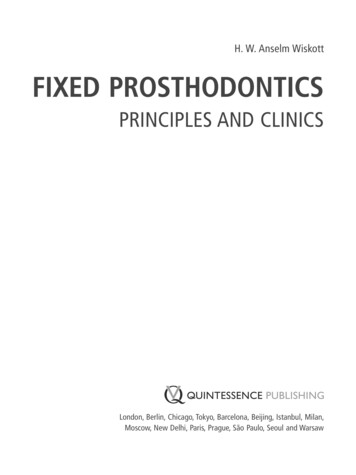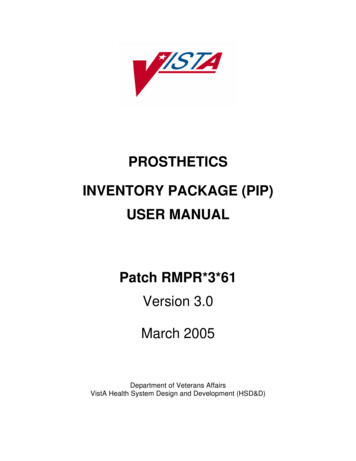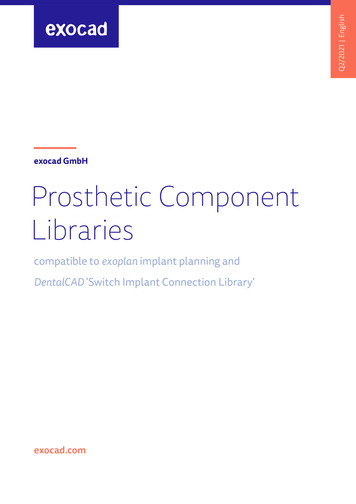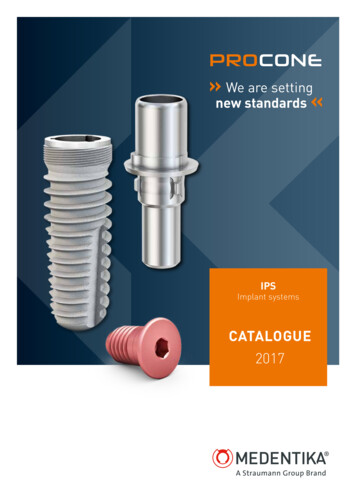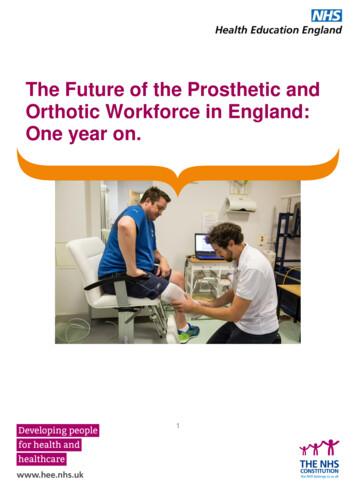
Transcription
The Future of the Prosthetic andOrthotic Workforce in England:One year on.1
The Future of the Prosthetic and Orthotic Workforcein England: One year on.ContentsExecutive SummaryWorkforce supplyPage55Core curriculum development6ApprenticeshipsE-learningUtilising the wider workforce effectively667Workforce planning7Communication and engagement7Conclusion7Introduction8Background9Who are Orthotists?9Who are Prosthetists?9How many Prosthetists and Orthotists are there?9How are Prosthetists and Orthotists trained?9How is the training funded?10How many are trained each year?10Outline of progress and next steps12Communication and engagement213
Workforce Supply14Awareness of profession/career profile14World of Work (WOW) careers TV project15Further careers opportunities17Work Experience19Strategic interventions in Health EducationDisciplines (SIHED) Programme19The Year of Engineering project20Return to Practice (RTP)22Workforce Developments Prior to Registration as a Prosthetist and Orthotist (Preregistration)24Core Curriculum Development24Entry routes: Level 6 (BSc) apprenticeships Level 6 degree apprenticeship Level 6 apprenticeship developmentmilestones252626Level 3 and 5 apprenticeships27Level 3 apprenticeship27Level 5 apprenticeship28Developing and supporting the learningenvironment30E-learning package30Workforce development Post-registration33Preceptorship33Utilising the wider workforce effectively34Support for Service Delivery343
Scoping exercise to explore the provision ofProsthetic and Orthotic skills within other AHPprofessions34Advanced clinical practice36Level 7 apprenticeship38Workforce planning38Acknowledgements40Appendix 1: Summary of futureactions414
Executive SummaryIn 2017, the report ‘The Future of the Orthotic and Prosthetic Workforce in England’ was published byHealth Education England (HEE). The report was written following an HEE education summit, whichlooked at the current issues facing the Prosthetic and Orthotic (P and O) workforce. This summit, held inJanuary 2017, was attended by delegates representing patients, clinicians, NHS England, NHSImprovement, Health Education England and various other bodies, including 34 NHS providers and 11commercial providers of P and O services.This current report describes the progress made one year on, towards improving the service.A summary of the areas looked at in this report follows below:Workforce supplyThere has historically been a low number of applications to undergraduate places to study P and O.Therefore, work to raise awareness of the profession has been essential: Health Careers website – all information has been updated and developed. Health Careers has recently collaborated on a scheme aimed at schools, called the World ofWork (WOW) TV project. This has produced a TV programme, that has introduced the roles toapproximately 18,000 school children. This project was run as a pilot and has the potential to beexpanded to a much wider audience. HEE is working with other organisations, such as ‘Medic portal’ and ‘Inspiring Futures’ to helpraise awareness of the profession. The P and O workforce will be able to tap into Higher Education Funding Council for England(HEFCE) funding offered by the Strategic Interventions in Health Education Disciplines (SIHED),which is a three-year, 3 million programme of work to support higher education in small,specialist healthcare disciplines that are experiencing difficulty in recruiting and retainingstudents. The British Association of Prosthetists and Orthotists (BAPO) are engaging in promoting theawareness of P and O within Science, Technology, Engineering and Mathematics (STEM)settings. The HEE/BAPO and other stakeholders will produce further materials, such as careerpresentations, which can be accessed and delivered by P and O professionals with schools,colleges and community groups. BAPO and service user groups will explore the value of developing impact stories from eliteathletes/Olympians/veterans.5
In addition, HEE has been looking at work experience and there is currently a work stream looking athow potential opportunities can be created.Finally, promotion of the AHP return to practice scheme is ongoing. HEE, BAPO and NHS providers willcontinue to support the identification of and upskilling of individuals to re-join the Healthcare ProfessionsCouncil (HCPC) to re-register as a P and O.Core curriculum developmentA core curriculum for all undergraduate Prosthetic and Orthotic courses is due to be published later in2018. This will build on the ‘Scope of Practice’ and ‘Competency Framework’ documents which havealready been published. These were produced after extensive work commissioned by BAPO andsupported by HEE.ApprenticeshipsThere has been much work carried out in developing P and O apprenticeships at levels 3 and 6.At level 3 support worker/technician roles have been created, which can support the HCPC-registered,qualified P and Os.At level 5 the Assistant Practitioner Apprenticeship Standard is being implemented. However, no specificwork has been undertaken at this stage to utilise this specifically for the P and O workforce or to developa specific level 5 apprenticeship standard for P and O. It is envisaged that the level 3 role will allow foraccess and progression to the level 6 apprenticeship, ensuring a clear pathway for the development ofthe P and O workforce.A level 7 multi-professional advanced practice apprenticeship has also been created, which will ensurenew opportunities across the P and O profession.It is important to keep attracting people into the role, ensuring that the Advanced Clinical Practice (ACP)opportunities are available to P and Os, as well as to other AHPs. This will help to realise innovativemodels of service delivery, as well as making the professions more attractive.E-learningHEE has commissioned and launched a pilot e-learning resource on the e-learning for healthcareplatform to support current learners and clinical educators during clinical placement experiences and tosupport preceptorship for newly qualified P and Os. This resource has been developed by the Universityof Salford and has been oversighted professionally by BAPO.6
Utilising the wider workforce effectivelyThere has been a scoping exercise to explore the core skills of other Allied Health Professional (AHPs)to ascertain if there is potential for some areas of P and O roles to be undertaken by other AHPs. Theconclusion from this exercise has been that, although there are some similarities between the AHPs,there are also some significant areas of knowledge and skills that are specific to P and O. Therefore,further work needs to be done to determine whether other professions can support the delivery of P andO management. This includes the need to explore educational programmes to support professional skillsdevelopment.Workforce PlanningHEE has worked with NHS Digital to ensure that the occupation codes for P and O have been includedin their NHS workforce data figures. The P and O workforce includes a significant number ofprofessionals who work in commercial organisations, and further work is still required to understandwider P and O workforce, vacancies and staffing. A data sharing agreement is being developed betweenall providers of NHS commissioned services and needs to be communicated and actioned appropriatelyby all employers of P and Os.Communication and engagementA new communications strategy will be put in place to ensure that all P and O stakeholders are kept upto-date with the latest information relating to the workforce.ConclusionOne year on from the last report, the majority of the actions from the planning event have beenachieved. New actions are set out in this document, which will continue to support and develop thestabilisation of the workforce.7
IntroductionIn July 2014 NHS England commissioned NHS Quality Observatory to undertake a review of orthoticsservices. The findings of the review were shared at a roundtable event in March 2015 and the key issuesand learning from the event were included in the report Improving the Quality of Orthotic Services in inEngland published in November 20151.In 2017, HEE responded to this, with the publication of a workforce report “The future of the prostheticsand orthotic workforce in England. This report summarised the outcomes of a Workforce Summit run inJanuary 2017 and sets out several actions. The Workforce Summit brought together the majority of NHSand Commercial providers, people with lived experience, educators and academics alongside HEE,NHSE and NHSI.This document will report on the actions to date and outline further plans required to support futureProsthetic and Orthotic (P and O) workforce development. Actions set out were co-produced in the toneof the education summit, which modelled the NHS constitution by valuing the input of all and placingpeople and populations at the heart of what we do.Prosthetics and orthotics is an exciting, challenging and diverse allied health profession which has arelatively small workforce spanning NHS, commercial, military and charitable sectors.This profession has faced and will continue to face several workforce challenges but good progress hasbeen made and there remains great commitment from all sectors including patient representatives, tocontinue to consolidate and develop the P and O workforce to ensure sustainable and quality servicedelivery.The British Association of Prosthetic and Orthotics (BAPO) continues to provide support and vision tolead the profession and has worked collaboratively with HEE to plan and action a strategy for future PAND O growth.1NHS England (2015) Improving the Quality of Orthotic Services in England. Available 8
BackgroundIt must be noted that a significant proportion of the prosthetic and orthotic workforce are employed bycommercial providers in England, providing NHS commissioned services. It is acknowledged thatensuring engagement and communication with all stakeholders requires a different approach.Who are Orthotists?Orthotists are autonomous registered practitioners who provide gait analysis and engineering solutionsto patients with problems and conditions of the neuro, muscular and skeletal systems. Theirqualifications make them competent to design, manufacture and provide orthoses (such as insoles,braces, splints, callipers, footwear, spinal jackets and helmets) that modify the structural or functionalcharacteristics of the patient’s neuro-muscular and skeletal systems. These then enable patients tomobilise, eliminate gait deviations, reduce falls, reduce pain, prevent and facilitate healing of ulcers. Inaddition, orthotists help people recover from, or avoid injury, or live with lifelong conditions.Who are Prosthetists?Prosthetists are autonomous registered practitioners who providegait analysis and engineering solutions to patients with limb loss.Their qualifications make them competent to design and provideprostheses that replicate the structural or functional characteristic ofthe patient’s absent limb.How many Prosthetists and Orthotists are there?‘Prosthetist’ and ‘Orthotist’ are protected titles in the UK and thereare now 1,051 Prosthetists and Orthotists registered with the Healthand Care Professions Council (HCPC) (18/04/18), compared to1,061 in June 2017. Of these approximately 5001 2 are estimated tobe working as orthotists across the UK.How are Prosthetists and Orthotists trained?They are extensively trained at undergraduate level in mechanics, bio-mechanics and material sciencealong with anatomy, physiology and pathophysiology and emerge as dual registered as P and O with aBSc in prosthetics and orthotics.12British Association of Prosthetists and Orthotists (2015) Improving the Quality of Orthotic Services in England.All Party Associate Parliamentary Group on Limb Loss (2014) Campaign for More Orthotists.9
Where are they trained?Currently there is only one university in England (and one other across the wider UK) offering aProsthetics and Orthotics programme: University of Salford offer a 3-year BSc (Hons) Prosthetics and Orthotics.(Moved from 4-year BSc (Hons) in 2012/13).NB. The University of Strathclyde offers a 4-year BSc (Hons) Prosthetics and Orthotics in Scotland.How is the training funded?Since the comprehensive spending review (CSR) in England and its implementation in September 2017,funding for P and O education costs have moved over to the Student Loan Company and are no longersupported by NHS bursaries and commissioned by HEE.How many are trained each year?Currently approximately 30 Orthotists and Prosthetists are trained each year in England. Prior to thespending review HEE commissioned 30 places per year. Since removal of the NHS bursary scheme,there has been concerns around a reduction in the numbers of those applying for places at HEIs inEngland to study P and O.In 2017-18, only 28 students enrolled to study P and O at the only UK P and O education provider inEngland; five of these students were identified during clearing.There has been a year on year reduction in applications at the same point compared to previous yearsand the HEI entered clearing in 2017/18 for the first time in many years in an attempt to recruit sufficientstudents (see figure 2). However, there are many confounding factors which may have influenced this,including removal of the bursary, Brexit and a changing age profile of the population with an overallreduction in the number of 18-year-olds applying to university.Academic year2017-182018-19Applications9073 (22% reduction)Offers5061 (22% rise)Accepted offers1512 (19% reduction)Figure 2 Recruitment for P and O undergraduate places in England on April 1.Overall there have been a 19% reduction in student applicants in 2018/9 compared to the same time inthe previous year, however more early offers have been made to appropriate applicants (22% increase),in an attempt to secure those students earlier. The number who have accepted offers are reducedcompared to this time last year (20%).10
Potential students will be waiting to make decisions and not all those accepting offers will take them updue to various reasons. Following removal of the commissioning cap there is a target of to recruit 35students for 2018/19 and further students will be sought during clearing.Many other health professions courses are also finding challenges to recruitment including learningdisability nursing, therapy radiography, orthoptics and podiatry. It is important to consider that as manyother similar courses will enter clearing for the first time due to under-recruitment, the competition forsuitable students will be higher.Prior to the removal of the NHS bursary, the P and O programme received applications in excess of therequired numbers from high calibre applicants and a selection process was used. The course had notentered clearing the in the three years prior to the removal of bursaries and some unsuccessful studentswere offered places on the P and O programme for the following year.HEE is working collaboratively with the office for students (OFS) to monitor small and vulnerableprofessions to ensure that courses remain viable during this transition phase post CSR and with thenational downturn in 18-year-olds, and the uncertainty of Brexit.This programme will be monitored closely in collaboration with the HEI provider and any new entrants tothe market, to ensure that the advent of apprenticeships does not destabilise existing undergraduateprovision.A generic one-year health foundation entry course will commence in 2018 at Salford University, whichwill prepare students for entry onto health degree courses including P and O which may increase thenumbers of applicants in future years.Academic entry tariffs will also be lowered to try and facilitate appropriate students to enter P and Oeducation programmes however it is important that students have the academic ability to complete thecourse.Prosthetists and Orthotists continue to be included on the Migration Advisory Committee ShortageOccupation List3.Future ActionHEE will work collaborativelywith the office for students tomonitor course uptake and thecontinued impact post CSR andthe impact of the apprenticeshipover time.ResponsibilityHEEOFS3TimescaleOngoing 6monthly reviewHM Government (2017) United Kingdom Shortage Occupation List. Available st11
Outline of progress and next stepsSeveral actions were laid out in the initial P and O workforce review. These previous actions arepresented with an update on progress to date with next steps identified for future work. Where actionshave been met these have been stated as achieved. Where further work is needed these have beenreconsidered as part of future action points. Workforce issues can be considered as those pertaining to;supply into the profession, pre-registration (during training) and post-registration as outlined in figure 2.Great strides have been made in the pursuit of securing and developing the P and O workforce, howeverthere is still much work to do.“The Orthotics Campaign is delighted to see the comprehensive range of strategiesthat this collaboration is implementing, with support from Health EducationEngland. Sadly, the patient experience of orthotic care has been seriously impactedover recent years by a lack of qualified and experienced orthotists. It is encouragingto see the level of commitment and hard work from all involved to address this, sopatients shall be able to access the care of compassionate, skilled orthotists in thefuture.”Rebecca Loo, Service User Representative, The Orthotics Campaign.12
Profile of Profession Career awareness Location of HigherEducation Institutions Entry routesapprenticeship andtraditional Applicant profile Work experience Support and technicalworkforceSupplyPreRegistration Curriculum Learningenvironment Clinical placementsand mentorship Return to practice gaining reregistration Mentorship Workforce data Support promotion ofprofession Advanced practice Influence of widerworkforce on P AND Oactivity Career paths Commissioning modelsPostRegistrationFigure 2: Factors identified as Influencing P and O Workforce.Communication and EngagementThroughout all the work done and consultation phases there it has been evident that there is a clearneed for improved communication between all P and O stakeholders. Communication of workforcedevelopments must be consistently disseminated through all parts of the P and O workforce includingNHS, commercial, education, service-user representatives and charitable sectors to ensure the whole Pand O workforce is informed and able to engage and collaborate.13
NEXT STEPSFuture ActionHEE will work with BAPO andcommercial, service user and NHSrepresentatives to ensure a clearcommunication strategy is in placeto disseminate information in acomprehensive and structuredway.ResponsibilityHEE, NHSrepresentatives,BAPO, Service userand commercial sectorTimescaleOct 2018Workforce supplyAwareness of profession/career profileActionBAPO will work with Health Careers to createupdated content to be uploaded on the HealthCareers website and included in any future HealthCareers publications.OwnerBAPO/Health CareersCompletion DateMay 2017ACHIEVEDMuch work has been done to raise awareness of P and O as profession and as an exciting andrewarding career choice. Health Careers has worked with BAPO to create and update resources for boththeir ‘Health careers’ website and ‘Step into the NHS’ websites, both aimed at increasing knowledge andawareness of all health professions including P and O.HEE commissioned an Allied Health Profession (AHP) digital audit to better understand where peoplewere directed to when searching for AHP careers or specific AHP careers information. The HealthCareers website was found to be the top ranking, non-sponsored UK website content when searching forP and O roles.During the period 1 April 2017 to 31 March 2018, Health Careers had 23,995 views of its pages relatingto P and O careers with 71% of those viewing pages relating to the prosthetic and orthotic roles with theaverage viewer spending over one and a half minutes on the pages. Some 179 went on to view the reallife case story video for P and O.14
The ’Step into the NHS’ website recently hosted a competition for Primary Schools and of the regionalwinners designed a poster featuring the role of prosthetist (see figure 637889207132160Figure 3: Winning regional poster featuring the role of prosthetist.World of Work (WOW) careers TV ProjectHEE provided the health segment of an innovative healthcareers project. The new WOW careers pilot TV channel wasstreamed live into 350 schools on 2 May 2018 and is nowavailable to view more widely on demand via You Tube. Thisunique project was sponsored by City and Guilds, The EdgeFoundation, the BandCE charitable foundation and a number ofnational employer organisations included HEE, as well as theLocal Enterprise Partnership network.15
Many employers including those in health subjects like P and O, face real challenges in recruiting youngpeople and this channel is aimed at breaking down the barriers between the classroom and theworkplace in a way that excites students and encourages them to explore the opportunities for thefuture.HEE has supported this project to promote the AHP, mental health and learning disability workforce.Prosthetists and orthotists are specifically featured within this film. The film features a bilateral lower limbyoung veteran amputee discussing his experiences of receiving both prosthetic and orthotic treatment.He talks about the value and difference it has made to his life.The programme aims to promote the profession to a younger audience to inspire them about aspects ofthe career such as care, compassion and making difference, whilst engaging with science andengineering concepts.View the video below.This pilot has included approximately 18,000 pupils in Cambridgeshire, Cornwall and London. The filmsand support materials are available online so can be accessed by the public, including those seekingcareers advice, parents and professionals. It is being promoted by BAPO and other NHS andcommercial organisations and schools.16
Supporting information about P and O careers was provided as part of teachers’ packs and lesson plans.A robust evaluation has been built around the world of work careers project which is planned forcompletion in June 2018. Specific Information from the pilot relating to P and O opportunities will beevaluated and used to inform future careers work.If successful, the pilot may lead to future commissioned, full 30-minute career programmes and HEE willcontinue to work with WOW careers TV to scope opportunities for specialist programmes, focussing onhealth careers which could include P and O (as well as support and technical roles) and encompassingboth traditional entry and apprenticeship routes.Further careers opportunitiesHEE is working with ‘The Medic Portal’ (https://www.themedicportal.com) which is accessed by 750,000people per year including young people, school leavers, parents, teachers and careers advisors who arespecifically interested in understanding careers in medicine. HEE will work with stakeholders to create aspecific page on the role of a P and O which will sit within a new dedicated web area on the medic portalwebsite to promote AHP careers.17
There is a great opportunity to promote wider health careers which may be better suited to someindividuals. P and O careers will also be promoted as part of wider AHP careers at events hosted by themedic portal.There remains a clear need to continue to focus on building and sharing visible and engaging careersinformation profile for P and O within the HEE health careers online presence and maximising its value.There are also opportunities to develop and capitalise on commercial sector and user perspectiveengagement work to promote P and O career routes including working with schools and colleges,charities and community groups.There is an opportunity to develop resources that can be used by all P and Os to engage with localschools and colleges to maximise opportunities to promote P and O careers. Examples included‘Inspiring the future’ (www.inspiringthefuture.org) which provides opportunities for AHPs and P and Os toregister to give one hour of time to talk in a local school about their career.18
Work ExperienceIt is acknowledged that there are limited opportunities for young people, as well as others wishing toenter the health professions, to gain quality work experience. This work experience needs to help giveinsight into the value and impact of the P and O practitioner and the support workforce. HEE is beginningwork to identify work experience opportunities, both through direct working with service providers, aswell as through specialist or simulated opportunities or events to expose individuals to the day to day lifeand work of P and Os and service user champions. Work experience needs to be provided at all levelsfor school students, and mature entrants. Work is planned with employers; university outreach andUniversity Technical Colleges and careers engagement was highlighted as part of the Chief Allied HealthProfessions Officers Conference in June 2019.Strategic Interventions in Health Education Disciplines (SIHED) ProgrammeIn March 2018, a 3 million programme of work was launched by what was the Higher EducationFunding Council for England (HEFCE) which is now the Office for Students (OFS), to support highereducation in small, specialist healthcare disciplines that are having trouble in recruiting or retainingstudents including P and O. The SIHED programme is expected to run for three years, starting in 201718, with a budget of 1 million per year.19
The SIHED programme aims to: increase awareness of allied health disciplinesincrease understanding of and demand for small specialist allied health disciplines including Pand Ostrengthen and diversify the delivery of the small and specialist disciplines including P and OIn 2017-18, the priority activities of the programme include: Recruitment of a fixed-term role to increase capacity for prosthetics and orthotics workplacements, facilitating more students to study P and O. This role will also coordinate thedevelopment of apprenticeship routes for prosthetics and orthotics, which should increase thecandidate pool for this disciplineDelivering a marketing and communications campaign to support student recruitment to smalland specialist allied health professions, including P and O from June 2018 onwardsDeveloping marketing materials to support recruitment to the disciplines in scope, from spring2018 to early summer 2018Appointing a P and O outreach and communications officer to support the development andraise the profile of P and O as a career choice.Supporting a wider healthcare and allied health professional recruitment campaign.Evaluating the project and sharing outcomes from autumn 2018.HEE is connected to this work to ensure it works in synergy with other HEE work and to maximiseimpact and avoid duplication.The Year of Engineering projectP and Os will be joining forces with government and industry to give thousands of young people inspiringexperiences of engineering, as part of a year-long campaign to tackle the engineering skills gap andwiden the pool of young people who join the profession.In November 2017, the government announced that 2018 will be the Year of Engineering #YoE, anational campaign to increase awareness and understanding of what engineers do among young peopleaged 7-16, their parents and their teachers. The campaign is encouraging young people from allbackgrounds to take a closer look at engineering, challenging stereotypes and showcasing the varietyand creativity of this forward-looking and innovative sector. BAPO are supporting the campaign on socialmedia focussing on the planned monthly themes. They have also worked with the consulting firm for#YoE. BAPO plan to continue to be involved in for the remainder of the year promoting P and O in thewider STEM area.20
Year of Engineering partners are highlighting some of the different ways that individuals andorganisations can #inspireanengineer on social media. The Year of Engineering launched in January2018. Further information can be found at the Year of Engineering partner website or follow the Year ofEngineering campaign on Twitter.Further work needs to be undertaken with the commercial sector and service user representatives tomaximise the profile of the year of engineering project.NEXT STEPSTo sustain a wider range of entry routes, it is essential that we raise the profile of P and O across thewider public population, promoting and championing the innovative and life-changing work P and Os doand the many opportunities it offers for a diverse and fulfilling career. Much work has been done to raisethe profile of P and O as a career across young people and mature students through several ongoingprojects. This needs to be continued and developed, through working with the Health Careers team, aswell as with service user representatives and commercial sector organisations. We must capitalise onthe drive to develop STEM subjects and the greater media coverage of para sport and veteran supportsuch as the Para-Olympics, Para-Commonwealth games and the Invictus games.We must also look to provide greater opportunities for individuals to gain access to high quality workexperience, either directly within the NHS and commercial workforce, or though specific events andopportunities to expose and engage people to the roles and practices of P and Os in suppor
O management. This includes the need to explore educational programmes to support professional skills development. Workforce Planning HEE has worked with NHS Digital to ensure that the occupation codes for P and O have been included in their NHS workforce data figures. The P and O workforce includes a significant number of


